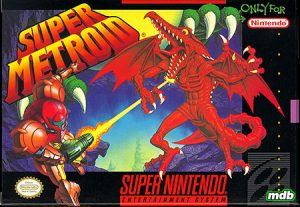 Review by: TJ Rappel
Review by: TJ Rappel
Original Publish Date: Pending
Final rating: “If you’re not nostalgic about the original Metroid, chances are you’ll find Super Metroid to be your favorite of the games thus far.”

Although the second Metroid game had been released in 1991, fans were already asking for the third before the year was up. The reason for this was because the Super Famicom had been released in Japan by the end of 1990, and all of those great series like Zelda and Castlevania had gotten (or were scheduled to get) their 16-bit facelifts. Samus’ fans couldn’t wait to see what Nintendo could pull off in the world of Metroid with their fabulous 16-bit machine. And we waited.
It wasn’t until the spring of 1994 that we found out, when Super Metroid was unleashed on the Super NES. At 24-Meg, it was the largest cartridge ever released at the time. With 16-bit power driving that 24-Meg cart, it was expected that the world of Metroid would be blown open like never before, and our friends at R&D1 did not disappoint.
Taking place almost immediately after Metroid II, the third chapter begins with Samus telling us how she took the Metroid hatchling which followed her out of SR388 at the end of the second mission to a scientific research facility located at Ceres Space Colony. The scientists found that the Metroids, originally thought to be a threat to life everywhere, could actually be used to benefit the galaxy with its energy-producing capabilities. Once Samus was assured that things were safe, she left the colony, only to recieve a distress signal on her way out — Ceres was under attack from none other than her old nemesis, Ridley and the Space Pirates. Thus begins her return to Zebes and take on Mother Brain’s forces once more.
Super Metroid implemented as many ideas into the Metroid framework as possible, making it the most diverse of the Metroid titles yet. Samus had most of her weapons from the first two games (with the exception of the Spider Ball), as well as new weapons, gadgets, and abilities. This made Samus more versatile than she had ever been before, now that she could swing from the ceiling on her Grappling Beam, run at incredible speeds with the Speed Boosters, and detect hidden passages with her X-Ray Scope. She gained the ability to aim her weapon in eight directions, roll into a ball while in midair, propel herself off walls and scale sheer cliffs, and so much more. The smooth gameplay from the first game had returned, and surprisingly (what with all the new moves she could pull off), Samus was still simple to control. This was of course vital, since she was now exploring areas of Zebes previously unseen and battling enemies hitherto unknown. Helping her along that end was a new auto-mapping system, built into the first subscreen to appear in the Metroid series.
My only complaint is that there weren’t nearly enough Metroids! The first game had those things rushing after you two or three at a time, hiding around corners, and coming out of the walls! The Metroids in Super were bigger, yes, but not as crafty or menacing. Otherwise, although I found some of the graphics to look a little bit rushed, and the challenge level just a smidgen too easy, Super Metroid proved to be everything that Metroid junkies had hoped for since they first blew away the Mother Brain in the original game. Great new music reprised that atmosphere that first drew me into the Planet Zebes, very cool puzzles blocked Samus’ way at every turn, and the Mother Brain had new surprises in store for us at the end of the game. If you’re not nostalgic about the original Metroid, chances are you’ll find Super Metroid to be your favorite of the games thus far.
